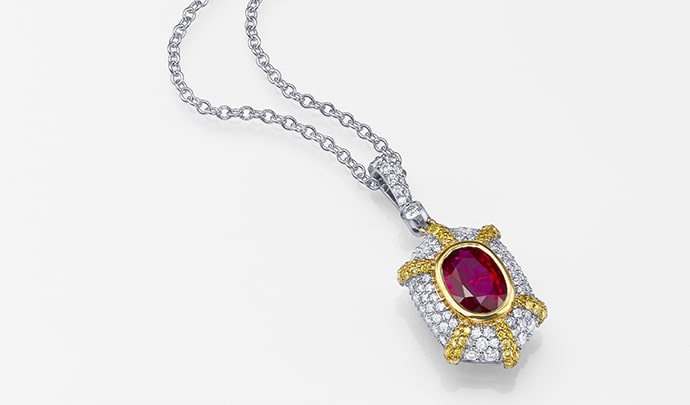Как узнать, настоящий ли рубин?
Зачастую натуральные драгоценные камни настолько красивы, что трудно поверить, что они “настоящие”, то есть не предполагали вмешательства человека. Вот почему многие люди спрашивают, настоящий ли Рубин. Ответ, конечно же, заключается в том, что подлинные, натуральные, ненагретые рубины очень реальны и абсолютно захватывают дух!

Рубины и бесцветные бриллианты
Они были найдены в природе с их феноменальным красным цветом и естественным блеском. Хотя большинство рубиновых драгоценных камней были огранены и отполированы, превратившись из грубого состояния в царственные и престижные драгоценности, они все еще так же реальны. Однако выращенные в лаборатории версии не являются реальными. Они не реальны, потому что они не подлинны и не естественны. Эти камни появились не в результате кропотливо долгого естественного процесса, а скорее были получены в лаборатории с помощью различных материалов и инструментов, многие из которых были введены только в прошлом веке или около того. Вот почему так важно различать настоящий, натуральный рубин и его лабораторно выращенный аналог.
Натуральные рубины
Рубины - это минералы из семейства корундовых, которые формировались под поверхностью земли на протяжении миллионов лет. Сапфиры также относятся к семейству Корунд. На самом деле красный цвет-это единственный аспект, который отделяет эти два драгоценных камня друг от друга. Рубины, как и сапфиры, занимают 9-е место по шкале твердости Мооса, сразу после бриллианта. Это говорит о том, что рубины являются довольно прочными камнями и являются сказочным выбором для украшения, учитывая их долговечность. Природные рубины гораздо более ценны, чем синтетические, а также гораздо более уникальны. Может быть, гораздо труднее найти тот, который имеет высокий уровень чистоты и по доступной цене, но то, что вы получаете, - это нечто замечательное и незаменимое. Культивированный Рубин может выглядеть так же для вас, и казаться вам идеально выглядящим драгоценным камнем, но это не то, что представляют собой драгоценные камни. Натуральные Рубины-это настоящие камни, и, как и бриллианты, они вечны.

Мозамбикский рубин и бриллиантовое колье
Настоящие рубины против рубинов, выращенных в лаборатории
Не каждый рубин, который вы встретите, будет настоящим рубином. Хотя большинство камней четко можно различать, многие из них все еще продаются как натуральные, хотя на самом деле они выращиваются в лабораторных условиях. Чтобы подготовиться к идентификации синтетического самозванца, вы должны знать несколько вещей о природных рубинах. Во-первых, большинство рубинов имеют какое-то вкрапление. Профессионал может помочь вам определить, является ли ваш Рубин безупречным, потому что только один из миллиарда идеален, или может он был выращен в лаборатории и поэтому был разработан, чтобы быть настолько совершенным и безупречным, насколько это возможно. Единственное, что может дать такой рубин - идеальный внешний вид и низкую цену. То же самое касается и низкой цены в целом. Рубины - это драгоценные камни, и, как настоящие бриллианты, изумруды и сапфиры, они могут стоить довольно дорого. Дешевая цена может очень хорошо указывать на то, что вы держите подделку. Размер Рубина также может помочь вам узнать подлинность вашего камня. Большие рубины трудно достать, и они очень дорогие. Если вы наткнулись на один или несколько рубинов, которые стоят недорого, скорее всего, они являются выращенными в лаборатории и не реальными.

Ненагретый натуральный красный рубин
Выращенные в лаборатории рубины были сделаны так, чтобы выглядеть
идентичными настоящим рубинам, поэтому различать их может быть чрезвычайно
трудно. Единственный способ узнать это наверняка-посмотреть на структуру камня
через микроскоп. Это должен делать специалист в данной области. Еще одна вещь,
которая может помочь защитить вас от покупки подделки, - это запрос на
сертификацию. Только подлинные, добытые рубины получают такие документы и могут
доказать свой статус.
Самое важное, что нужно сделать, - это определить продавца, которому вы
можете доверять. С широким распространением Интернета вы всегда можете искать
отзывы других людей. Идея заключается в том, чтобы чувствовать себя абсолютно
комфортно с вашей покупкой.
